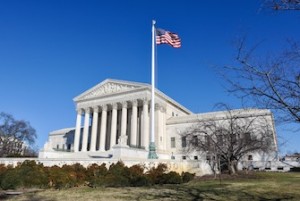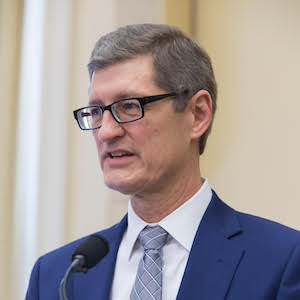“In the course of its opinion in SAP America, Inc. v. InvestPic, LLC, the Federal Circuit created a ‘physical realm’ test, which is nowhere to be found in 35 U.S. Code Section 101, having been wholly conjured by judges.”
 Among the seven amicus curiae briefs filed Monday with the U.S. Supreme Court in InvestPic, LLC, v. SAP America, Inc., Eagle Forum Education & Legal Defense Fund’s brief argues that the case demands a hearing because the Federal Circuit has added yet another extra-statutory test to the already distorted patentability jurisprudence.
Among the seven amicus curiae briefs filed Monday with the U.S. Supreme Court in InvestPic, LLC, v. SAP America, Inc., Eagle Forum Education & Legal Defense Fund’s brief argues that the case demands a hearing because the Federal Circuit has added yet another extra-statutory test to the already distorted patentability jurisprudence.
In a decision of May 15, 2018 authored by Judge Taranto, the Federal Circuit found the patent claims of U.S. Patent No. 6,349,291 invalid because they were directed to an abstract idea and lacked an inventive concept necessary to save the invention under 35 U.S.C. § 101.
In the course of its opinion, the Federal Circuit created a “physical realm” test, which is nowhere to be found in 35 U.S. Code Section 101, having been wholly conjured by judges. Such a requirement to be eligible for a patent would render novel, useful, nonobvious inventions unpatentable—purely on grounds outside the statute and ill-suited for the Information Age.
The amicus curiae notes “a vast domain of subject matter that should be patentable” between truly abstract ideas and the physical. This includes, for example, “complex algorithms, software, computer operating systems, clever business processes, website innovations, e-commerce inventions, medical diagnostic techniques, data compression, error detection, signal processing.”
Eagle Forum ELDF observes how the Supreme Court rejected the Federal Circuit’s “machine-or-transformation test” in Bilski v. Kappos. The “physical realm” test in InvestPic resurrects the same rejected concept. The Supreme Court again rejected such a requirement for patent eligibility in Alice Corp. v. CLS Bank, holding that “an invention is not rendered ineligible for patent simply because it involves an abstract concept.”
Furthermore, the Federal Circuit’s “physical realm” test is “anachronistic,” the brief argues, and unsuited to the inventions of the Information Age. The consequences of such an “archaic” standard, termed the “horse-and-buggy mindset of the Federal Circuit, is contributing to the forces compelling patent applications to be filed overseas rather than here.”
The amicus curiae illustrates the danger of this judicially induced slide by quoting the IPWatchdog article on St. Jude Children’s Research Hospital’s reassessment of its IP strategy, due to the raft of destructive 101 rulings: “Uncertainty about being able to get a patent and license it weighs against pursuing diagnostics and computer-implemented inventions—at least in the United States.”
Other notable amicus briefs include U.S. Inventor.

![[IPWatchdog Logo]](https://ipwatchdog.com/wp-content/themes/IPWatchdog%20-%202023/assets/images/temp/logo-small@2x.png)

![[Advertisement]](https://ipwatchdog.com/wp-content/uploads/2024/04/Patent-Litigation-Masters-2024-sidebar-early-bird-ends-Apr-21-last-chance-700x500-1.jpg)

![[Advertisement]](https://ipwatchdog.com/wp-content/uploads/2021/12/WEBINAR-336-x-280-px.png)
![[Advertisement]](https://ipwatchdog.com/wp-content/uploads/2021/12/2021-Patent-Practice-on-Demand-recorded-Feb-2021-336-x-280.jpg)
![[Advertisement]](https://ipwatchdog.com/wp-content/uploads/2021/12/Ad-4-The-Invent-Patent-System™.png)







Join the Discussion
7 comments so far.
Anon
April 18, 2019 11:27 am“A claimable process cannot be disembodied from existents in reality.”
“Where I come from, magic and science are one thing.” – Thor (paraphrased).
Yes, even the “mystic” and “supernatural” are part of the “physical world” if one wants to use “physical world” as a pseudonym for reality.
But that is NOT how “physical” is being used, now is it?
Anon2
April 18, 2019 10:32 am@5 Correction. That should read:
“evades the fact that a physical system performing real actions of a process CANNOT BE nothing but an abstraction”
Anon2
April 18, 2019 09:17 amAnon@2
IF “physicality” is properly interpreted “process” does carry a physicality requirement.
A claimable process cannot be disembodied from existents in reality. Whether the process involves iron, chemicals, biological material, complex systems involving metal, silicon, readable media, optical fiber, protons, electrons, and yes even photons… all processes properly covered by 101 are in the context of the natural (as against the mystical or “super” natural…) physical world.
My point is that a test invoking a “hard goods” standard is incorrect precisely because it excludes so much which is actually part of the physical world of manufactures and processes and hence actually eligible.
You, as well as I, know that claiming principles, mental activity, or math wholly as such, i.e. in the abstract is NOT the same as claiming physical structure and/or action in reality.
The problem of conflating reality with abstraction is generally not a problem that you personally possess… but it is a problem which causes an invalid definition of the physicality requirement… which evades the fact that a physical system performing real actions of a process is nothing but an abstraction.
Conflation of mental contents with existence, and reification of abstraction are fallacies that rightly should be grown out of by the time one graduates highschool… assuming they have any intelligence.
Anon
April 17, 2019 04:02 pmAnon2,
In your mind does the pure (unaltered by the Court) statutory category of “process” carry a physicality requirement?
Remember, that Congress acted in 1952 to EXPAND beyond the old notion that “art” was merely a handmaiden of the “hard goods” categories.
Anon2
April 17, 2019 01:58 pmWhat is so unfortunate, is not that a “physicality requirement” has been introduced (either now or in the past as mentioned by anon as claimed by the Office), but that the standard implicit in the physicality requirement as expounded(old or new) is likely improper.
A proper physicality requirement is already implicit in the categories and exclusivities listed in 101, and would be perfectly fine if the test kept in mind what in reality 101 actually means.
Anon
April 17, 2019 12:48 pmThere was a USPTO outreach program recently (a Business Methods Partnership Meeting) and this topic came up.
The Office referred to an old Chemical case for the “holding” that there is a physicality requirement. I do not recall that case off hand.
B
April 17, 2019 12:14 pmFirst – seven, not eight, amici.
Second – not to crowd the brilliant writings of Andrew Shafly (Eagle Forum), but the amicus filed for Villena stated the same thing, i.e., that the “physical realm improvement” test has no place in s101.
Investpic is also an assault on functional claiming, which is allowed and addressed in 112(f).